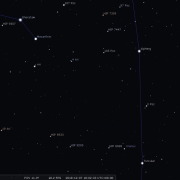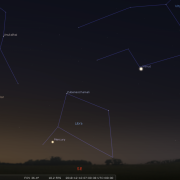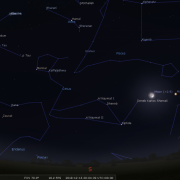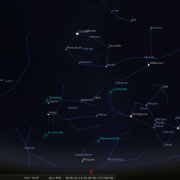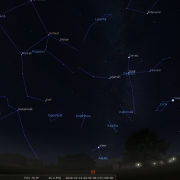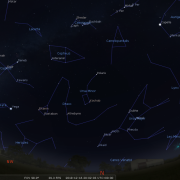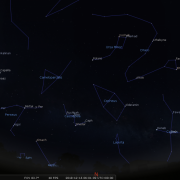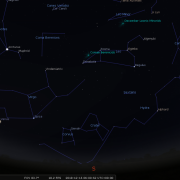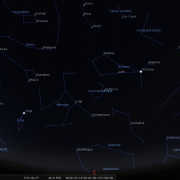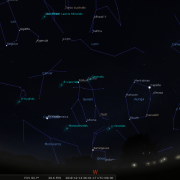In this month's Sky Notes:
Planetary Skylights
Evening
 Time to bid Saturn farewell as it finally drops into bright evening twilight over in the Southwest; and is lost by early midmonth. If you want a challenge try spotting it, and a very slim crescent Moon which lies upper left on Dec 9th around 16:15h.
Time to bid Saturn farewell as it finally drops into bright evening twilight over in the Southwest; and is lost by early midmonth. If you want a challenge try spotting it, and a very slim crescent Moon which lies upper left on Dec 9th around 16:15h.

 This leaves Mars as the only conspicuous evening planet visible, which if you have been keeping tabs on, has stayed ahead of the twilight, gaining in altitude and moving eastwards so that it still resides to the south as dusk falls. Appearing somewhat fainter and smaller through the eyepiece than in the summer, surface markings can nevertheless still be glimpsed if air seeing is good.
This leaves Mars as the only conspicuous evening planet visible, which if you have been keeping tabs on, has stayed ahead of the twilight, gaining in altitude and moving eastwards so that it still resides to the south as dusk falls. Appearing somewhat fainter and smaller through the eyepiece than in the summer, surface markings can nevertheless still be glimpsed if air seeing is good.
 Mars is heading diagonally up through Aquarius and during early December is involved in a spectacular conjunction with the outer gas giant Neptune. You will spot Neptune with a pair of binoculars, but if you have a telescope, even of modest size, turn it toward the orange hue of Mars on Dec 7th and you will spy the tiny grey/blue disk of Neptune close by Mars in the same field of view! (Also try 6th and 8th should it be cloudy) The moon passes below Mars on the 14/15th.
Mars is heading diagonally up through Aquarius and during early December is involved in a spectacular conjunction with the outer gas giant Neptune. You will spot Neptune with a pair of binoculars, but if you have a telescope, even of modest size, turn it toward the orange hue of Mars on Dec 7th and you will spy the tiny grey/blue disk of Neptune close by Mars in the same field of view! (Also try 6th and 8th should it be cloudy) The moon passes below Mars on the 14/15th.
 At magnitude +5.75 Uranus is readily visible in binoculars; however, to discern its small grey/green disk, a telescope will be required. During mid evening Uranus is located across in the south, approximately two degrees to the left of the star omicron Pisces; Torcularis Septentrionalis, although Uranus actually lies in the extreme lower right corner of Aries. The stars Sheratan and Mesarthim point down to Omicron Piscium. The Gibbous moon passes several degrees below on the 17th/18th.
At magnitude +5.75 Uranus is readily visible in binoculars; however, to discern its small grey/green disk, a telescope will be required. During mid evening Uranus is located across in the south, approximately two degrees to the left of the star omicron Pisces; Torcularis Septentrionalis, although Uranus actually lies in the extreme lower right corner of Aries. The stars Sheratan and Mesarthim point down to Omicron Piscium. The Gibbous moon passes several degrees below on the 17th/18th.
Neptune is located in the SSW within the constellation of Aquarius, approximately a binocular field lower left of the asterism known as the ‘water jar’ and the a few degrees to the left of Lambda Aquarii. You will require a telescope to identify it, appearing as a tiny blue/grey disk. Look for it just below /left of 81 Aquarii. It is involved with an extremely close encounter with Mars on the 6th, 7th and 8th of December, making it a splendid opportunity to track down the outermost major planet.
Morning
 The December dawn sky is backdrop to further planetary close encounters. The month starts with brilliant Venus low in the southeast to the left of Spica – chief star in Virgo. Look for a very slender crescent moon in the vicinity on the 3rd and 4th viewing at approximately 07:15h.the 6th.
The December dawn sky is backdrop to further planetary close encounters. The month starts with brilliant Venus low in the southeast to the left of Spica – chief star in Virgo. Look for a very slender crescent moon in the vicinity on the 3rd and 4th viewing at approximately 07:15h.the 6th.
 Then by the 6th look for elusive Mercury just above the SE horizon (lower left of Venus) By the 12th it has brightened sufficiently to be easily visible to the naked eye. Look due SE (bearing + 135 degrees) a binocular field above the horizon to spot it. However don’t confuse it with the emerging and far brighter planet Jupiter, which from the 15th heads toward a splendid conjunction with Mercury.
Then by the 6th look for elusive Mercury just above the SE horizon (lower left of Venus) By the 12th it has brightened sufficiently to be easily visible to the naked eye. Look due SE (bearing + 135 degrees) a binocular field above the horizon to spot it. However don’t confuse it with the emerging and far brighter planet Jupiter, which from the 15th heads toward a splendid conjunction with Mercury.
 The two are closest on the 21st and 22nd around 07:30h when Mercury will be above-left of Jupiter. By the end of the month Mercury has once again departed, leaving Jupiter and Venus closing together into the new year.
The two are closest on the 21st and 22nd around 07:30h when Mercury will be above-left of Jupiter. By the end of the month Mercury has once again departed, leaving Jupiter and Venus closing together into the new year.
Meteors

Considered now to be the most prolific annual meteor shower, the Geminids are active from December 7th-16th, reaching a peak on December 14th.
Geminids originate from debris shed by a small asteroid called Phaethon, which may even be the nucleus of a ‘dead’ comet. Phaethon passes within ten million miles of the Sun causing the object to deposit material over great swathes of the inner solar system. However it is only within the last eighty years that Geminid activity has increased to the levels now recorded, a result of Earth passing through a much denser debris strand, a situation that will only continue for another hundred years or so.
A typical Geminid meteoroid is about the size of a large coffee granule, which penetrates deep into Earth’s atmosphere before ‘burning up’ - (two processes; known as ablation and ionisation) Brighter Geminids regularly produce long luminous trails, sometimes green or orange in hue. The shower radiant lies close to Castor, visible in the East by 21:00h.
Under ideal conditions the theoretical zenith hourly rate (ZHR) can approach 120 per hour. However observed rates will be somewhat lower, and a quarter moon will be in the evening sky on the 14th sky until 22:30h. My tip would be to observe late on the 13th and into the early morning hours of the 14th (until 02:00h) and then again from 22:00h of the 14th – 02:00h of the 15th. Expect to see actual rates of around 20 per hour before midnight, rising to 50 and above from midnight until 03:00h.
Conditions for the less prolific Ursid meteor shower, which is active from Dec 17th-25th, peaking on Dec 22nd and 23rd will be less favourable, coinciding with the full moon. Under good conditions hourly rates of around 10 are the norm, but occasionally and erratically, Ursids can produce strong outbursts, though I think any activity this year will be drowned out by moonlight. The radiant lies close to the Great Bear - up in the Northeast.
Comets
Comet 46P/Wirtanen continues to gradually ‘brighten’ and by mid December is well placed for UK observers racing up through Taurus. This short-period comet (5.4 years) at just over 1km in diameter reaches perihelion passage on 16 December when it will pass 0.078 AU (7,220,000miles) from Earth, about as close as it can get.
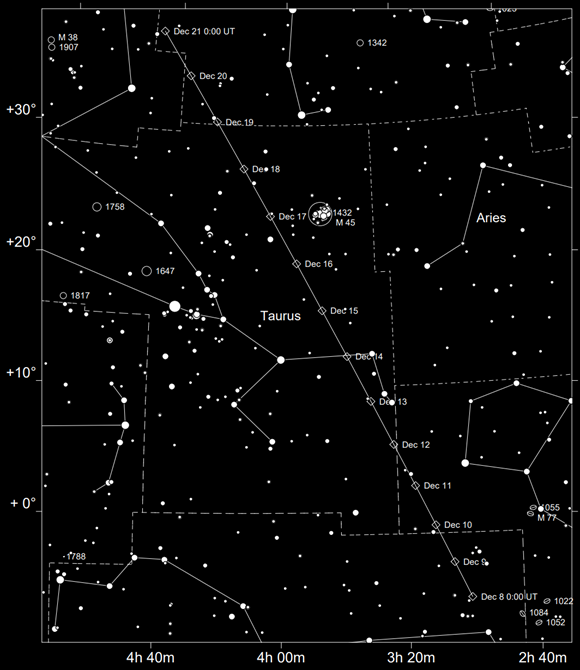
Finder Chart for Comet 46P/Wirtanen during December 2018
At this point Comet 46P/Wirtanen is predicted to become borderline naked eye, perhaps Magnitude 4.7 (we shall see) It will be moving through Taurus below the Pleiades at 0.2 degrees per hour – it’s shifting! Observe after The Moon has set.
46P was the original target for ESA’s Rosetta spacecraft, but the launch window was missed so 67P/Churymov-Gerasimenko was chosen instead.
Winter Solstice
The Sun reaches its lowest position in the sky on December 21st this year; the date of the winter solstice and officially the start of winter in the Northern hemisphere.

From our latitude the Sun arcs barely 12 degrees above South horizon at local noon, and useful daylight amounts to just 7½ hrs ’the shortest day’.
Latest sunrise and earliest sunset do not however occur on the winter solstice date. The Sun sets earliest mid-month (15th or 16th) and rises latest near the end of December (27th or 28th).
Within a month evenings will begin to grow lighter again, a fact not lost on our distant forefathers and a cause for thanks giving and celebration... mmmm... Happy solstice everyone!
December 2018 Sky Charts
|
Looking North
Mid-December - 20:00h |
Looking South |
|
Looking East
Mid-December - 20:00h |
Looking West
Mid-December - 20:00h |
|
Northern Aspect
Mid-December - 20:00h |
Southern Aspect
Mid-December - 20:00h |
| Looking North (Early) Mid-December - 06:00h |
Looking South (Early) Mid-December - 06:00h |
| Looking East (Early) Mid-December - 06:00h |
Looking West (Early) Mid-December - 06:00h |
Additional Image Credits:
- Planets and Comets where not otherwise mentioned: NASA
- Sky Charts: Stellarium Software
- Winter Solstice image: Mike Peel (Winter Solstice from Stonehenge)
- Log in to post comments


